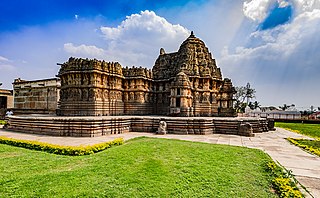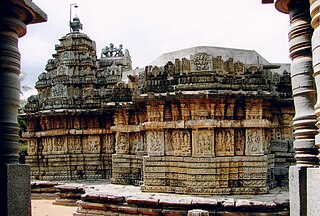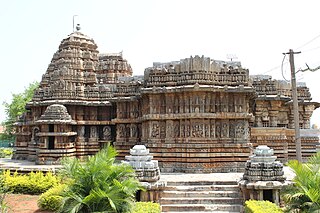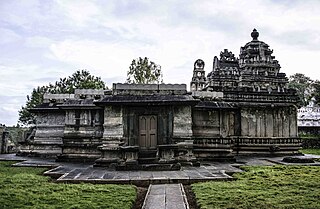
Hoysala architecture is the building style in Hindu temple architecture developed under the rule of the Hoysala Empire between the 11th and 14th centuries, in the region known today as Karnataka, a state of India. Hoysala influence was at its peak in the 13th century, when it dominated the Southern Deccan Plateau region. Large and small temples built during this era remain as examples of the Hoysala architectural style, including the Chennakesava Temple at Belur, the Hoysaleswara Temple at Halebidu, and the Kesava Temple at Somanathapura. These three temples were accorded UNESCO world heritage site status in 2023. Other examples of Hoysala craftsmanship are the temples at Belavadi, Amruthapura, Hosaholalu, Mosale, Arasikere, Basaralu, Kikkeri and Nuggehalli. Study of the Hoysala architectural style has revealed a negligible Indo-Aryan influence while the impact of Southern Indian style is more distinct.

Lakshmi Narasimha Temple, also referred to as Lakshminarasimha temple of Bhadravati, is a 13th-century Hindu temple dedicated to Vishnu, built by the Hoysala ruler Vira Someshwara. It is located in Bhadravati, Shimoga District of Karnataka state, India. The temple opens to the east and has three sanctums, one each dedicated to Venogopala, Lakshminarasimha and Vishnu-Puroshottama. It is notable for its Vesara architecture, with artwork that includes legends and deities of Vaishnavism, as well as those of Shaivism, Shaktism and Vedic deities. Important reliefs include those of Ganesha, Dakshinamurti, Bhairava, Sarasvati, Brahma, Surya, Harihara, and others. The temple's original shikaras were ruined, and have been restored with a conical structure. According to Adam Hardy – a scholar of Indian temple architecture, this temple has two "exceptional" stellate structures highlighting the architectural sophistication of the Hoysalas.

The Lakshmi Narasimha temple is a 13th-century Hindu temple with Hoysala architecture in Nuggehalli village, Hassan district, Karnataka, India. This three shrine Vaishnava complex is dedicated to Keshava, Lakshmi Narasimha and Venugopala. It was built in 1246 CE by Bommanna Dandanayaka, a commander in the Hoysala Empire during the rule of King Vira Someshwara.

Chennakeshava Temple, also referred to as Keshava, Kesava or Vijayanarayana Temple of Belur, is a 12th-century Hindu temple in, Hassan district of Karnataka state, India. It was commissioned by King Vishnuvardhana in 1117 CE, on the banks of the Yagachi River in Belur, an early Hoysala Empire capital. The temple was built over three generations and took 103 years to finish. It was repeatedly damaged and plundered during wars, repeatedly rebuilt and repaired over its history. It is 35 km from Hassan city and about 220 km from Bengaluru.

The Veera Narayana temple, also referred to as the Viranarayana temple of Belavadi, is a triple Hindu temple with a complex Hoysala architecture completed around 1200 CE. Close to Halebidu, this is a better preserved large Hoysala monument found in the small village of Belavadi, Chikkamagaluru district of Karnataka, India.

The Lakshminarayana Temple is a 13th-century Hindu temple with Hoysala architecture in Hosaholalu, Mandya district of Karnataka, India. Dedicated to Vishnu, this three-shrine monument is notable for its finely carved plinth (adhisthana) with panels of the Ramayana, the Mahabharata and the Bhagavata Purana. It has one of the most beautifully embellished Hoysala tower projection (sukanasa) that integrates the Dravida motifs with asta-bhadra Bhumija motifs from central India. Also notable are polish and jewelry-like carvings inside the temple's mandapa.

The Ishvara temple, also referred to as the Ishwara or Isvara temple, is an early 13th-century Hindu temple in Arsikere, Hassan district, Karnataka India. Dedicated to Shiva, it is one of the most notable early Hoysala architecture examples with a rotating circular plan, a domed mandapa with 16-point star shape, a pancatala vimana, and a galaxy of artwork depicting Shaivism, Vaishnavism, Shaktism and Vedic legends of Hinduism.

The Chennakeshava temple, dedicated to the Hindu god Vishnu, is located in Aralaguppe, a small town in Karnataka state, India. Aralaguppe is located 60 km from the city of Hassan. The temple was built around 1250 during the rule of the Hoysala Empire King Vira Someshwara. The temple is a protected monument under the Karnataka state division of the Archaeological Survey of India.

The Amruteshvara temple also spelt "Amrutesvara" or "Amruteshwara", is located in the village of Amruthapura, 67 km north of Chikmagalur town in the Chikkamagaluru district of the Karnataka state, India. Located 110 km from Hassan and 50 km from Shimoga on NH 206, Amruthapura is known for the Amruteshvara temple. The temple was built in 1196 CE by Amrutheshwara Dandanayaka under Hoysala King Veera Ballala II.

Bucesvara temple, also referred to as the Buceswara, Bucheshwara or Bhucheshvara temple, is a 12th-century Hindu temples in Koravangala village, Karnataka, India. The most sophisticated historical temple in the village, it is considered to be the flag-bearer of Hoysala architecture and was built by a wealthy patron named Buchi during the reign of king Ballala.

The Mallikarjuna temple, dedicated to the Hindu god Shiva, is in Basaralu, a small town in the Mandya district, Karnataka state, India. Basaralu is close to Nagamangala and about 65 km from the culturally important city of Mysore. The temple was built by Harihara Dhannayaka around 1234 A.D. during the rule of the Hoysala Empire King Vira Narasimha II. This temple is protected as a monument of national importance by the Archaeological Survey of India.

The Lakshminarasimha temple at Haranhalli, sometimes referred to as Lakshmi Narasimha temple of Haranhalli, is one of two major historic Hindu temples that have survived in Haranhalli, Karnataka, India. It is triple-shrine temple dedicated to Vishnu, while the other – Someshvara Temple, Haranhalli few hundred meters to the east – is dedicated to Shiva. Both temples reflect a Vesara-style Hoysala architecture, share similar design ideas and features, and were completed in the 1230s by three wealthy brothers – Peddanna Heggade, Sovanna and Kesanna.

The Lakshminarasimha temple at Javagal, sometimes referred to as Lakshmi Narasimha temple of Javagallu, is a mid-13th century Hindu temple with Hoysala architecture. It is located in Javagal about 20 km northeast from Halebidu and 50 km from Hassan city, Karnataka state, India. This triple shrine temple is dedicated to Narasimha – the man-lion avatar of Vishnu. It was completed between 1250 and 1260 CE by King Vira Someshwara of the Hoysala Empire.

The Kaitabheshvara temple is located in the town of Kubatur, near Anavatti in the Shimoga district of Karnataka state, India. The temple was constructed during the reign of Hoysala King Vinayaditya around 1100 AD. The Hoysala ruling family was during this time a powerful feudatory of the imperial Western Chalukya Empire ruled by King Vikramaditya VI. According to the Archaeological Survey of India, the architectural signature of the temple is mainly "Chalukyan". Art historian Adam Hardy classifies the style involved in the construction of the temple as "Later Chalukya, non mainstream, far end of spectrum". The building material used is soapstone The temple is protected as a monument of national importance by the Archaeological Survey of India.

Kedareshwara Temple is a Hoysala era construction in the historically important town of Halebidu, in the Hassan district of Karnataka state, India. It is located a short distance away from the famous Hoysaleswara Temple. The temple was constructed by Hoysala King Veera Ballala II and his Queen Ketaladevi, and the main deity is Ishwara. The temple is protected as a monument of national importance by the Archaeological Survey of India.

The Rameshvara temple is a 12th-century Shiva temple in Kudli, Shimoga district, Karnataka India. It is an early non-ornate, Hoysala construction with simpler Vesara style. The village of Koodli – also spelled Kudli, Kudali – was a major town through the 14th-century and of great antiquity, with ruins of over eight major Hindu temples and monasteries. It is located about 18 kilometres (11 mi) north-east of Shimoga city, the district headquarters. The town gets its name because it is situated at the confluence of the Tunga and Bhadra tributaries that form the Tungabhadra river.

The Chennakeshava temple, dedicated to the Hindu god Vishnu is located in Turuvekere, a small town in the Tumkur district, Karnataka state, India. Turuvekere, founded as an Agraharam town in the 13th century is located about 77 miles from the state capital Bangalore. The temple was built around 1263 A.D. during the rule of the Hoysala Empire King Narasimha III. This temple is a protected monument under the Karnataka state division of the Archaeological Survey of India.

The Chennakeshava temple, dedicated to the Hindu god Vishnu is located in the village of Hullekere, in the Arasikere Taluk, about 22 km from the commercial town Arasikere. It was built in 1163 A.D. by a minister of Hoysala empire king Narasimha I. The art historian Adam Hardy categorizes the architectural style as a single shrine (vimana) construction with miniature vimanas, the basic building material being Soap stone. The monument is protected by the Karnataka state division of Archaeological Survey of India.

The Lakshminarasimha temple at Vignasante is a 13th-century Vishnu temple in the village of Vignasante, Tumkur district, Karnataka, India. The three-shrine temple is dedicated to Venugopala, Narasimha and Lakshmi Narayana. One of the late temples built before Hoysala empire came under sustained attacks from the Delhi Sultanate, it illustrates the mature Hoysalanadu architectural tradition. The fully carved, three storey Vesara vimana of this temple is notable.

The Someshvara temple at Haranhalli, sometimes referred to as Somesvara temple of Haranhalli, is one of two major historic Hindu temples that have survived in Haranhalli, Karnataka, India. It is dedicated to Shiva, while the other – Lakshminarasimha Temple, Haranhalli few hundred meters to the west – is dedicated to Vishnu. Both temples reflect a Vesara-style Hoysala architecture, share similar design ideas and features, and were completed in the 1230s by three wealthy brothers – Peddanna Heggade, Sovanna and Kesanna.





































